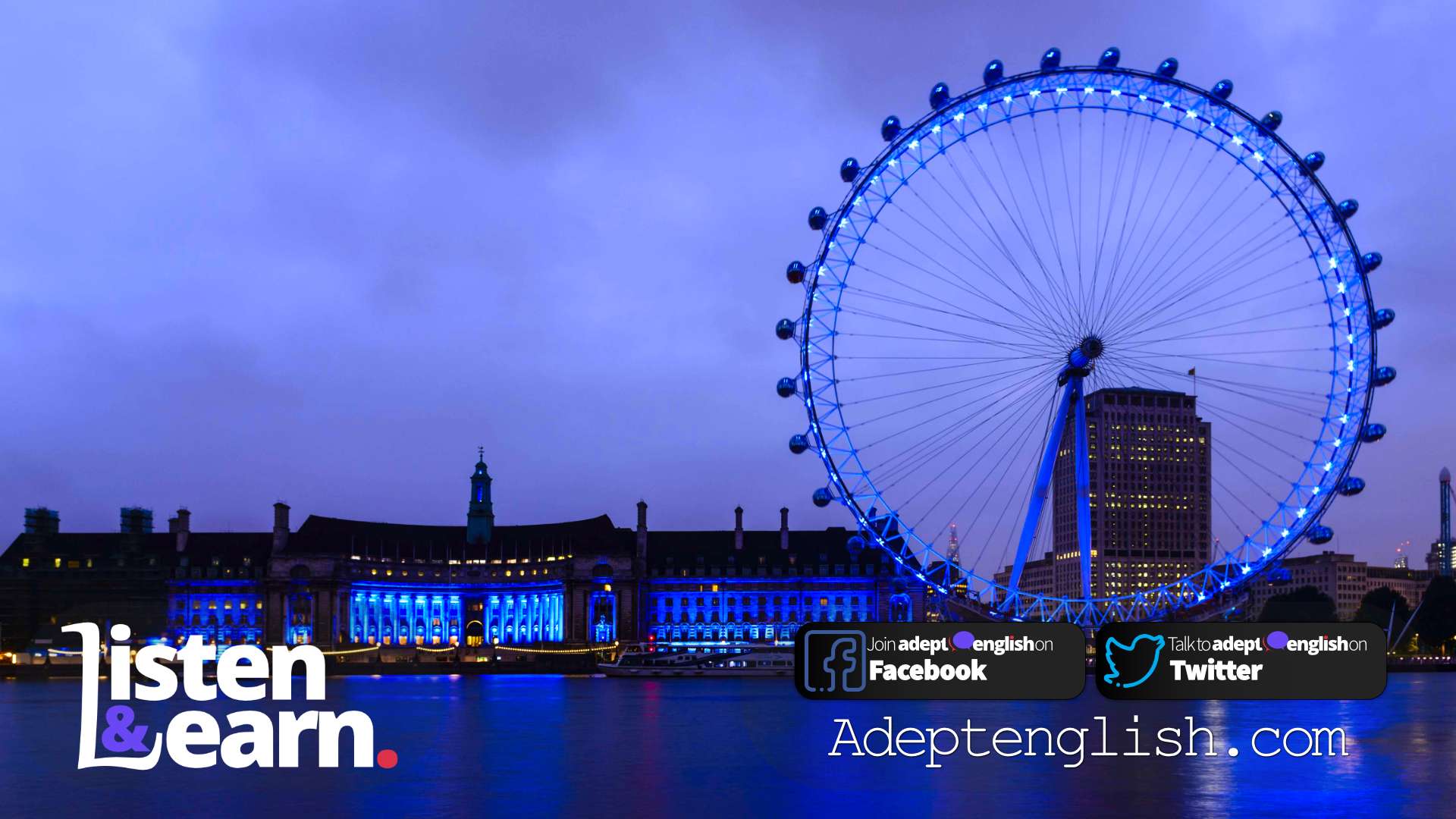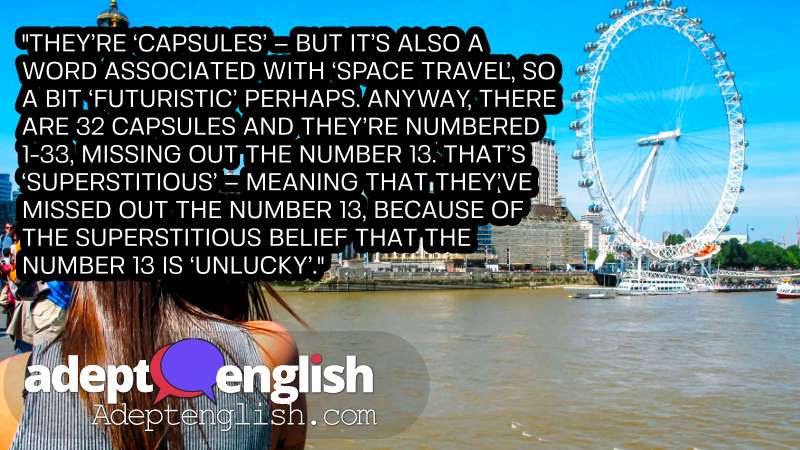English Listening Practice Podcast For English Language Learners
Start your English listening practice with the Adept English language podcast. Each podcast helps develop your English listening skills with all the stress removed. This is a practice podcast for English language learners. It features useful phrases used in everyday speaking, pronunciation tips, and common grammar rules. All you have to do is listen and learn.
Listening practice is at the heart of any English study and one of the best ways to improve your spoken and written English. The secret is finding a variety of topics that interest you and that can be difficult. Our Learn English Through Listening podcasts bring you a variety of interesting listening practice lessons. With 2 new podcast episodes for you to listen to every week. The topics will be unique so if you subscribe to this podcast, you will always have something new and interesting for listening practice.
If you are looking for an engaging English listening practice, which is based on authentic material. What if I told you that there is a free podcast series in which you learn English by listening to interesting stories in everyday English? This English listening practice podcast is just one of over 450 in the Learn English Through Listening podcast series.
You won’t find better or more comprehensive free English language listening material that helps learners of English as a foreign language to develop their listening and speaking skills. Aided by a free transcript, learners can listen to the podcast while looking up any hard words or phrases.
Most Unusual Words:
Unique
Authentic
Capsule
Landmark
Millennium
Conqueror
Most common 2 word phrases:
| Phrase | Count |
|---|---|
| You Can | 4 |
| You Might | 3 |
| Podcast Download | 2 |
| The Tourist | 2 |
| To Visit | 2 |
| Our Podcasts | 2 |
Listen To The Audio Lesson Now
The mp3 audio and pdf transcript for this lesson is now part of the Adept English back catalogue . You can still download and listen to this lesson as part of one of our podcast bundles.Transcript: Improve Your English Listening Skills With English Listening Practice
Hi there and welcome to this podcast from Adept English.
So if you like variety in your podcasts and you prefer listening to something which is an interesting topic, rather than an English lesson, then you’ll like today’s podcast. It’s another account of a visit to a major tourist attraction in the UK – and somewhere you might want to visit yourself if you come to the UK.
Boost Your Learning With Adept English
And if you want more variety to listen to in our podcasts, then why not visit our podcast download page on our website at adeptenglish.com, where for a small fee, you can download 100s of our podcasts. And these are ones that are no longer available online! What a bargain – and what a way to ensure that your English language just keeps on improving.
A ‘staycation’ for summer 2021
Anyway, today’s podcast? Well, I’m continuing my ‘staycation’ and in effect part of my time has been spent relaxing, and some of my time has been spent on Adept English – and for other parts of this 10 day holiday, I’ve been effectively ‘the tourist in my own country’.
It’s quite a common phenomenon that you might live in or near an interesting city, like London – or many other cities of the world – but you don’t often take the time to visit the tourist attractions yourself. Or you only go there, when you’ve got visitors that you’re showing around. So this week has been an opportunity for me to do some of that. I told you about Woburn Safari Park. So where else have we been?
Statistics about the London Eye
Well, we visited the London Eye. This is the big structure near Waterloo Station on the south bank of the River Thames, which you can see for miles around. It’s ‘a big wheel’ – the sort that you might encounter in a theme park. The London Eye is a huge, round structure which stands 135 metres or 433 feet tall.
It’s the largest one of its type in Europe and there are no fewer than 3 million visitors every year. It was built in the year 2000, so it’s just had its twentieth birthday. It was originally a temporary structure – that means ‘not permanent, not here to stay’. And it was put there to mark the Millennium – or the year 2000 – that’s MILLENNIUM. But it proved so popular that it became a permanent feature.
The London Eye is the 2nd highest point that you can observe London from. It’s been overtaken by the viewing platform at the top of The Shard, that’s SHARD – and the name of that building comes from the English word for a sharp piece of broken glass or pottery. And indeed The Shard does look very sharp, poking up above London’s skyline.
The Shard is 309 metres tall, or 1,016 feet high. However, they’re cheating a little – the highest part that you can actually stand on is on the 72nd floor at 244 metres or 801 feet. But that’s pretty high and I’m told that it’s not for people who fear heights or have vertigo!
Up we go on the London Eye
So back to the London Eye. What’s also different about it, is that you travel round in a ‘capsule’. These are glass and shaped like an oval – and they take normally around 25 people per capsule. A ‘capsule’, CAPSULE in English usually refers to those things medicines or pills that you swallow with water – that’s what the medicine is inside - a ‘gel capsule’. So things like a paracetamol or Vitamin.
They’re ‘capsules’ – but it’s also a word associated with ‘space travel’, so a bit ‘futuristic’ perhaps. Anyway, there are 32 capsules and they’re numbered 1-33, missing out the number 13. That’s ‘superstitious’ – meaning that they’ve missed out the number 13, because of the superstitious belief that the number 13 is ‘unlucky’. And you don’t want ‘bad luck’ when you’re suspended 433 feet up, I guess!
📷
A photograph of a the London Eye. English Listening Practice Podcast.
The word ‘superstition’ in English is the noun – and it means ‘a belief, usually that bad things will happen, and the belief isn’t based on fact’. So missing out the number 13 on the capsules is ‘superstitious’ – that’s the adjective to go with ‘superstition’. The capsules are air conditioned, in case it’s a sunny day – and it takes about 30 minutes, half an hour to go all the way round.
You’re moving at a speed of 10 inches per second – and the wheel doesn’t stop for people getting on and off. You get in and out of the capsule while it’s moving! You’d think that that was perhaps only for the sprightly – but actually, it’s quite slow moving, so it’s not difficult.
What can you see from the London Eye?
What can you see from the London Eye? Well, the River Thames is very prominent – and it’s the major landmark throughout London anyway. A ‘landmark’, LANDMARK is a compound word – and it means a ‘way of marking the land’ – a feature of the landscape which you might use to navigate, to find your way.
We talk about the South Bank, meaning the ‘south side of the Thames’ – and people talk about being ‘south or north of the river’. And of course, from the London Eye, you can see the big structures along the London skyline, like The Shard and the Walkie Talkie and The Gherkin – and One Canada Square in east London too, where I work for part of the week. They can all be seen from the London Eye. And of course, if you go up one of the other buildings, you can easily pick out the London Eye too – these buildings look back at one another! And way down below, you can see the Palace of Westminster, the British parliament building and Big Ben – the clock tower alongside.
‘Big Ben’ is actually the bell, but the tower is often referred to as ‘Big Ben’. I did a podcast a long while ago – about on of the most photographed views across a bridge in the UK – that’s the view across Westminster Bridge. Well if you’re on the London Eye, you can see that from on high! Big Ben is currently covered in scaffolding. ‘Scaffolding’ is the structure alongside a building, which enables work to be carried out to the building. And Big Ben and its tower are having a lot of work done. It seems to be taking a long time, anyway. The scaffolding is still there.
Video
What very old buildings can you see from the London Eye?
If you’re looking for ‘Old London’ rather than modern London buildings, there is plenty to see too. You can see St Paul’s Cathedral. The construction of St Paul’s began in 1666, just after The Great Fire of London – and this church is famous for its dome and for being where Prince Charles married Lady Diana Spencer.
Download The Podcast Audio & Transcript
Even older, you can see the Tower of London, over to the east, next to the river. This is where we visited on a different day of this week. And this building – or at least the part of the Tower called ‘The White Tower’ – well, if you’re looking for ‘old’, this is it.
The construction of this building was started by William the Conqueror, the French Norman King, after his conquest of the English at the Battle of Hastings in 1066. Or it was a little after 1066 that he started to build it. Good building technique, given that The White Tower is still standing sturdy a thousand years later! That’s perhaps another podcast – the Tower of London.
Waterloo Station and London’s parks from the London Eye
You can also see Waterloo Station, which is one of London’s main railway stations, serving the area south west of London. And you’ll notice just how green much of London is. There are many parks, from the Palace Gardens behind Buckingham Palace to St James's Park and Green Park through to Hyde Park and onwards to Kensington Gardens. Again, I’m like a tourism ambassador for London sometimes in these podcasts, aren’t I? I’ve talked about London’s parks in a podcast earlier this year.
Goodbye
So if you go do to London, then I imagine one of the things on your list of thing you want to do, would be the London Eye. It’s great for photographs of course, but better if the weather is nice! It was a little bit grey when we were there. Never mind!
Anyway, enough for now. Have a lovely day. Speak to you again soon. Goodbye.












